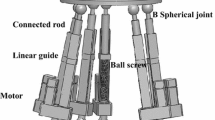Abstract
This paper investigates the minimum-energy joint path-following problem for space manipulators whose base attitude is stabilized by reaction wheels. In the problem, manipulator joint path is specified for rest-to-rest motion and constraints are imposed as the upper bound on both motion completion time and the voltage/current limits of DC motors in manipulator joints and reaction wheels. We suggest a simple two-stage algorithm to address this problem. The algorithm first tries to find a global optimal solution by solving a relaxed convex problem. If the convex relaxation is not successful, then the algorithm solves subproblems iteratively to find a suboptimal solution. Since both problems are formulated as second-order cone programming (SOCP) form, they can be solved efficiently using dedicated SOCP solvers. The effectiveness of the proposed method is verified by numerical experiments.







Similar content being viewed by others
References
Belousov I, Ferre E, Laumond JP, Esteves C (2005) Motion planning for the large space manipulators with complicated dynamics. In: 2005 IEEE/RSJ international conference on intelligent robots and systems, IEEE, pp 2160–2166
Bobrow J, Dubowsky S, Gibson J (1985) Time-optimal control of robotic manipulators along specified paths. Int J Robot Res 4(3):3–17
Boyd S, Vandenberghe L (2009) Convex optimization. Cambridge University Press, New York
Choset H, Lynch KM, Hutchinson S, Kantor GA, Burgard W, Kavraki LE, Thrun S (2005) Principles of robot motion: theory, algorithms, and implementation. Cambridge, Massachusetts
Ellery A, Kreisel J, Sommer B (2008) The case for robotic on-orbit servicing of spacecraft: spacecraft reliability is a myth. Acta Astronaut 63(5–6):632–648
Flores-Abad A, Ma O, Pham K, Ulrich S (2014) A review of space robotics technologies for on-orbit servicing. Prog Aerosp Sci 68:1–26
Fortescue P, Swinered G, Stark J (2003) Spacecraft systems engineering, 3rd edn. West Sussex, England
Kennedy C, Desai J (2005) Modeling and control of the Mitsubishi PA-10 robot arm harmonic drive system. IEEE/ASME Trans Mechatron 10(3):263–274
Kim YM, Kim BK (2014) Energy-efficient trajectory generation for space manipulators with reaction wheels under a fixed base orientation. J Intell Robot Syst 76(2):219–237
Leahy MB Jr, Saridis GN (1989) Compensation of industrial manipulator dynamics. Int J Robot Res 8(4):73–84
Lobo MS, Vandenberghe L, Boyd S, Lebret H (1998) Applications of second-order cone programming. Linear Algebra Appl 284(1–3):193–228
Löfberg J (2004) YALMIP: a toolbox for modeling and optimization in MATLAB. In: 2004 IEEE international symposium on computer aided control systems design, IEEE, pp 284–289
Oki T, Nakanishi H, Yoshida K (2010) Time-optimal manipulator control for management of angular momentum distribution during the capture of a tumbling target. Adv Robot 24(3):441–466
Reynoso-Mora P, Chen W, Tomizuka M (2013) On the time-optimal trajectory planning and control of robotic manipulators along predefined paths. In: 2013 American control conference, IEEE, Washington, DC, USA, pp 371–377
Shiller Z (1996) Time-energy optimal control of articulated systems with geometric path constraints. J Dyn Syst Meas Control 118(1):139–143
Shin KG, McKay N (1985) Minimum-time control of robotic manipulators with geometric path constraints. IEEE Trans Autom Control 30(6):531–541
Shin KG, McKay ND (1986) A dynamic programming approach to trajectory planning of robotic manipulators. IEEE Trans Autom Control AC-31(6):491–500
Sturm JF (1999) Using SeDuMi 1.02, a MATLAB toolbox for optimization over symmetric cones. Optim Methods Softw 11(1–4):625–653
Verscheure D, Demeulenaere B, Swevers J, De Schutter J, Diehl M (2009) Time-optimal path tracking for robots: a convex optimization approach. IEEE Trans Autom Control 54(10):2318–2327
Wigström O, Lennartson B (2011) Energy optimization of trajectories for high level scheduling. In: 2011 IEEE conference on automation science and engineering (CASE), IEEE, Trieste, Italy, 24–27 August 2011 pp 654–659
Wigström O, Lennartson B, Vergnano A, Breitholtz C (2013) High-level scheduling of energy optimal trajectories. IEEE Trans Autom Sci Eng 10(1):57–64
Yoshida K, Wilcox B (2008) Space robots. In: Siciliano B, Khatib O (eds) Springer handbook of robotics, chap. 45, pp 1031–1063. Springer, Berlin
Yoshida K (2009) Achievements in space robotics. IEEE Robot Autom Mag 16(4):20–28
Zhang Q, Li S, Guo JX, Gao XS (2015) Time-optimal path tracking for robots under dynamics constraints based on convex optimization. Robotica 34(9):2116–2139
Author information
Authors and Affiliations
Corresponding author
Rights and permissions
About this article
Cite this article
Kim, YM., Kim, BK. Energy-efficient joint path-following for attitude-fixed space manipulators with bounds on completion time and motor voltage/current. Intel Serv Robotics 10, 1–11 (2017). https://doi.org/10.1007/s11370-016-0211-8
Received:
Accepted:
Published:
Issue Date:
DOI: https://doi.org/10.1007/s11370-016-0211-8




